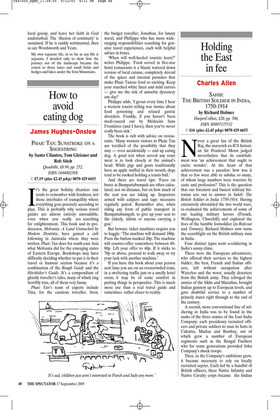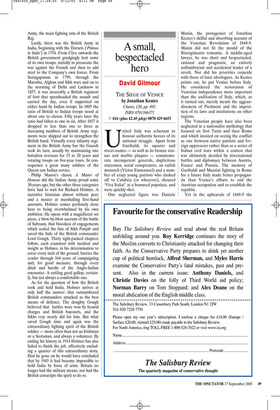Holding the East in fee
Charles Allen
SAHIB: THE BRITISH SOLDIER IN INDIA,
1750-1914
by Richard Holmes HarperCollins, £20, pp. 506, ISBN X0007137532 ✆ £16 (plus £2.45 p&p) 0870 429 6655 Never a great fan of the British Raj, the maverick ex-ICS historian Sir Penderel Moon judged nevertheless that its establishment was ‘an achievement that ought to excite wonder’. At the heart of that achievement was a paradox: how was it that so few were able to subdue so many, of whom large numbers were warriors by caste and profession? This is the question that our foremost and busiest military historian sets out to answer in Sahib: The British Soldier in India 1750-1914. Having extensively chronicled the two world wars, re-evaluated the achievements of some of our leading military heroes (French, Wellington, Churchill) and explored the lives of the humble footsoldier (in Redcoat and Tommy), Richard Holmes now turns the searchlight on the British military man in India.
Four distinct types went a-soldiering in India’s sunny clime.
There were the European adventurers, who offered their services to the highest bidder; the best, French and Italian officers, left without occupation after Waterloo and the worst, usually deserters from the British army. They reforged the armies of the Sikhs and Marathas, brought Indian gunnery up to European levels, and gave doubtful service to a number of princely states right through to the end of the century.
A second, more conventional line of soldiering in India was to be found in the ranks of the three armies of the East India Company: each presidency recruited officers and private soldiers to man its forts in Calcutta, Madras and Bombay, out of which grew a number of European regiments such as the Bengal Fusiliers who for some generations provided John Company’s shock troops.
Then, as the Company’s ambitions grew, it became necessary to rely on locally recruited sepoys. Each led by a handful of British officers, these Native Infantry and Native Cavalry corps became the Indian Army, the main fighting arm of the British Raj.
Lastly, there was the British Army in India, beginning with the Dorsets (‘Primus in Indis’) in 1754. From Clive onwards the British government grudgingly lent some of its own troops, initially to prosecute the war against the French and then to add steel to the Company’s own forces. From Seringapatam in 1799, through the Maratha, Afghan and Sikh wars and on to the storming of Delhi and Lucknow in 1857, it was invariably a British regiment of foot that spearheaded the assault and carried the day, even if supported on either hand by Indian troops. In 1805 the ratio of British to Indian troops stood at about one to eleven. Fifty years later the ratio had fallen to one in six. After 1857 it dropped to less than one to three as increasing numbers of British Army regiments were shipped out to strengthen the British hand. Virtually every infantry regiment in the British Army bar the Guards took its turn, usually by maintaining one battalion overseas for 15 to 20 years and rotating troops on five-year tours. In consequence a great many soldiers of the Queen saw Indian service.
Philip Mason’s classic A Matter of Honour did the Indian Army proud some 30 years ago, but the other three categories have had to wait for Richard Holmes. A narrative historian almost without peer and a master at marshalling first-hand accounts, Holmes comes perilously close here to being overwhelmed by his own ambition. He opens with a magnificent set piece, a blow-by-blow account of the battle of Subraon, that bloodiest of engagements which sealed the fate of Sikh Punjab and saved the hide of the British commander Lord Gough. Thirty tight-packed chapters follow, each crammed with incident and insight as Holmes, in his determination to cover every inch of the ground, hurries the reader through 164 years of campaigning and, for good measure, through every ditch and hurdle of the Anglo-Indian encounter. A rattling good gallop, certainly, but not always a comfortable one.
As for the question of how the British took and held India, Holmes arrives at only half the answer: that outnumbered British commanders attacked as the best means of defence. The doughty Gough believed that battles were won by frontal charges and British bayonets, and the Sikhs very nearly did for him. But what saved Gough time and again was the extraordinary fighting spirit of the British soldier — more often than not an Irishman or a Scotsman, and always a volunteer. By ending his history in 1914 Holmes has also failed to finish the job, effectively excluding a quarter of this extraordinary story. Had he gone on he would have concluded that by 1945 it had become impossible to hold India by force of arms. Britain no longer had the military means, nor had the British conscripts the spirit to do so.




















































 Previous page
Previous page